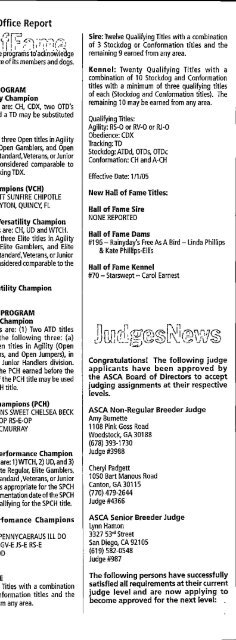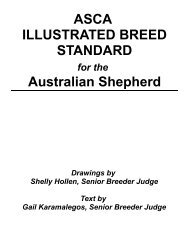Create successful ePaper yourself
Turn your PDF publications into a flip-book with our unique Google optimized e-Paper software.
there were a few basic things we needed<br />
to know: inheritance, neonatal health, litter<br />
size, tail status ofparents, and tail status of<br />
offspring. Inheritance can be deduced from<br />
either studying a large sample or several<br />
generations, and by looking for clues in<br />
other breeds. Submitting samples for a<br />
DNA test to determine if the gene for the<br />
NBT inAussies is that same as in Pembroke<br />
Welsh Corgis is one way of arriving at<br />
an answer more quickly. I am currently<br />
investigating the possibility of doing this<br />
and will post information at a later date if<br />
it is indeed doable.<br />
Meanwhile, I will be collecting<br />
Australian Shepherd litter information<br />
through this year (<strong>2005</strong>) and then<br />
publishing the results. The information I<br />
need from breeders takes a relatively short<br />
amount of time to fillout and provide to me.<br />
Most ofthe data have been sent to me via e-<br />
mail, as the data forms are available online<br />
or can be e-mailed as attachments upon<br />
request (my e-mail is imgnr@dnaco.net").<br />
Pictures are helpful to verify tail lengths,<br />
plus I may ask to use some for the final<br />
article; however, they are not mandatory.<br />
I request a five-generation pedigree, some<br />
general information on the parents (such as<br />
previous litter sizes and tail status before<br />
docking, if known), and then the litter data<br />
(which includes tail length or category, total<br />
number ofpups, number of stillborn pups.<br />
In Other Words<br />
and notes on any neonatalhealth problems,<br />
particularly in regards to the spinal area or<br />
hind quarters). That's it.<br />
As of this writing, I have just over<br />
50 litters in the study. The more data, the<br />
more accurate the findings will be, so any<br />
and all breeders are invited to contribute,<br />
including litters with all full tails as well<br />
as those with NBT pups in them. Full tail<br />
litters will help serve as a control group<br />
for comparison. The objectives of this<br />
study are to determine a possible mode<br />
of inheritance for the natural bobtail trait,<br />
to find out whether or not there is any<br />
clear correlation between the presence<br />
of the gene and neonatal health defects,<br />
or if the presence of the gene leads to a<br />
reduction in litter size or has no effect on<br />
it. Early results indicate that the gene for<br />
the NBT in Aussies may be inherited in the<br />
same manner as it is in Pembroke Welsh<br />
Corgis—a dominant gene with modifying<br />
factors that determine actual tail length<br />
in the NBTs—as it appears that a NBT<br />
parent will usually produce some NBT<br />
pups, no matter who that dog is bred to.<br />
Whether or not it is the same gene as the<br />
Pembrokes could only be proven by DNA<br />
testing. It is unclear whether there is an<br />
increase in spinal defects or other serious<br />
health problems, as there simply has not<br />
been enough of these problems reported<br />
in this study thus far. It could be because<br />
that although spina bifida and imperforate<br />
anus do exist, they are actually rare in our<br />
breed. In the matter of litter size when the<br />
NBT trait is present—a final analysis of<br />
data will give us some indication about<br />
this, but thus far litter sizes have varied<br />
in both litters with all full tails and litters<br />
with NBTs present. What will be most<br />
interesting to see is what crosses ofNBT x<br />
NBT will produce in the way oflitter size,<br />
but at this point there have not been enough<br />
of such crosses to state anything one way<br />
or another.<br />
The two data sheets needed for<br />
participation in this study may be<br />
downloaded from http://www.dnaco.net/<br />
~imgnr/nbt study.htm or received<br />
as attachments directly from me at<br />
imgnr@dnaco.net. Although pedigrees will<br />
be requested on all litters to help determine<br />
the mode of inheritance, no information<br />
will be disclosed to the public (or to any<br />
individuals). Everything is confidential.<br />
Study results will only contain numerical<br />
data. No pedigree information or specific<br />
sires or dams will be mentioned.<br />
My thanks to Heike Poole, again, for helping<br />
me make sure I understood the German laws<br />
before putting them into my own words, and to<br />
CASharpfor helping me create the data sheets<br />
andher input. Atid ofcoursemany, many thanks<br />
to all those breeders out there who have sent<br />
along data and shared information!<br />
☆<br />
<strong>AT</strong>TENTION EXHIBITORS<br />
☆<br />
Would you like to know when and where the Conformation, Obedience, Stock Dog<br />
and Agility Trials are?<br />
Subscribe to the "ASCA Sanctioned Shows and Trials Newsletter^"<br />
Name<br />
Address.<br />
City<br />
Email<br />
State<br />
.Zip.<br />
Subscription : • $35.00 per year Regular Mail<br />
• $10 per year Email<br />
(Paid byCheck, Money Order, Master Card/Visa)<br />
Makechecks/ money orders payable to: ASCA, and send to:<br />
ASCA Business Office<br />
PC 80X 3790<br />
Bryan, TX 77805-3790<br />
Phone 979-778-1082 Fax 979-778-1898 Email: agility@asca.org<br />
Credit Card:<br />
Expiration Date:<br />
Number:<br />
Sign here:<br />
Newsletters are mailed the 15th of every month.<br />
108 AUSSIE TIMES I <strong>July</strong>-<strong>Aug</strong>ust <strong>2005</strong>



